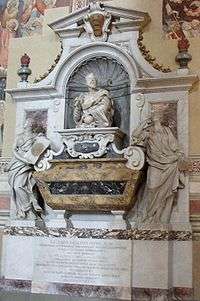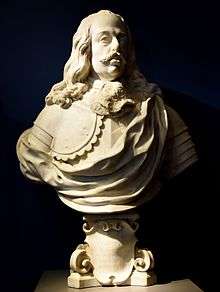Giovanni Battista Foggini
Giovanni Battista (Giambattista) Foggini (25 April 1652 – 12 April 1725) was an Italian sculptor active in Florence, renowned mainly for small bronze statuary.[1]
Giovanni Battista Foggini | |
|---|---|
| Born | 25 April 1652 |
| Died | 12 April 1725 (aged 72) |
| Nationality | Italian |
| Known for | Sculpture |
| Movement | Baroque |

Biography
Born in Florence, the young Foggini was sent to Rome by the Medici Grand Duke of Tuscany to join the so-called Accademia Fiorentina, and apprentice in the Roman sculptural studio of Ercole Ferrata, a pupil of Algardi. He was also tutored in drawing by the Accademia's first director (1673–86), Ciro Ferri, who was a pupil of Cortona. Returning to Florence in 1676, he became the court sculptor for Cosimo III.[2]
After the son of Pietro Tacca, Fernando, died in 1686, the mantle of the premier local sculptor fell to Foggini, who would become the Medici's Architetto Primario e Primo scultore della Casa Serenissima as well as Soprintendente dei Lavori (1687–1725).[3] In 1687, Foggini acquired the foundry in Borgo Pinti that had once belonged to the sculptor Giambologna. This allowed him to specialize in small bronzes,[4] produced mainly and profitably for export. His adaptation of Pietro Tacca's Moors was the basis of bronze and ceramic reproductions for the connoisseur market well into the 18th century.[5]
In Florence, his masterpieces are his sculptural relief work in the Capella Corsini of the Chiesa del Carmine. The chapel was erected by Bartolomeo and Cardinal Neri Corsini in memory of their recently canonized[6] ancestral family member, San Andrea Corsini. It contains three large marble reliefs depicting his life: San Andrea in Glory, The Mass of San Andrea Corsini and The Battle of Anghiari (1685–87). He also completed works in Cappella Feroni in the Annunziata. Another work is the main staircase of the Medici-Riccardi Palace in Florence.
Among his small bronzes are David with the Head of Goliath.[7]
Foggini's pupils included Fernando Fuga, his nephew Filippo della Valle, Balthasar Permoser, Giovacchino Fortini and Giovanni Baratta. Massimiliano Soldani Benzi was a contemporary student with Foggini in Rome and also active in small bronze sculpture.
Gallery
- Grand Duke of Tuscany Cosimo III de Medici - 1683 - Metropolitan Museum of Art, New York City
- Grand Prince Ferdinando de Medici - Giovanni Battista Foggini - 1683 - Metropolitan Museum of Art - New York City
 Ferdinando II de' Medici, Grand Duke of Tuscany - 1690 - National Gallery of Art, Washington, DC
Ferdinando II de' Medici, Grand Duke of Tuscany - 1690 - National Gallery of Art, Washington, DC Bust of Cosimo III de' Medici, 1717-1718 CE. By Giovanni Battista Figgini. Marble, from Italy, Florence. The Victoria and Albert Museum, London
Bust of Cosimo III de' Medici, 1717-1718 CE. By Giovanni Battista Figgini. Marble, from Italy, Florence. The Victoria and Albert Museum, London
Notes
| Wikimedia Commons has media related to Giovanni Battista Foggini. |
- Kurt Lankheit, Florentinische Barockplastik, 1962; The Twilight of the Medici: Late Baroque Art in Florence, 1670-1743, (Florence 1974).
- See Foggini's portrait of the duke
- Cannon-Brookes, p. 778
- See Web Gallery of Art image.
- See Anthea Brook's article in The Slave in European Art: From Renaissance Trophy to Abolitionist Emblem, ed. Elizabeth McGrath and Jean Michel Massing, London (The Warburg Institute) and Turin 2012.
- Died 1373 and canonized in 1629 by Urban VIII
- An example is in the Cleveland Museum of Art (Frederick Den Broeder and John D. Cooney, "Giovanni Battista Foggini: David with the Head of Goliath", The Bulletin of the Cleveland Museum of Art 54.1 [January 1967:22-26]).
External links
- Wittkower, Rudolf (1993). Pelican History of Art (ed.). Art and Architecture Italy, 1600-1750. 1980. Penguin Books.
- Bruce Boucher (1998). Thames & Hudson, World of Art (ed.). Italian Baroque Sculpture. pp. 164–66, 188–89.
- Gli Ultimi Medici, Review by Peter Cannon-Brookes, in The Burlington Magazine, 1974, p 777-80.